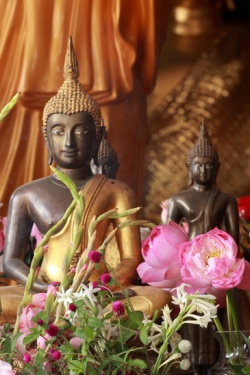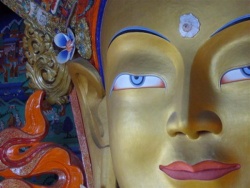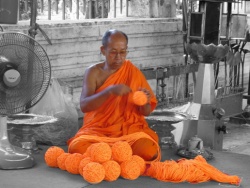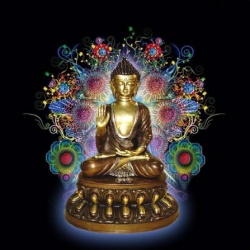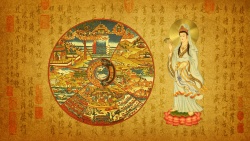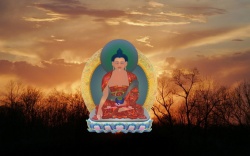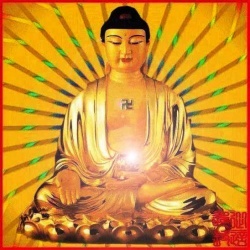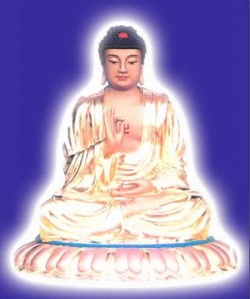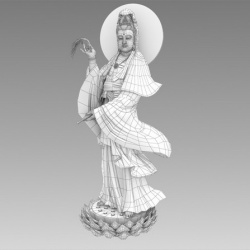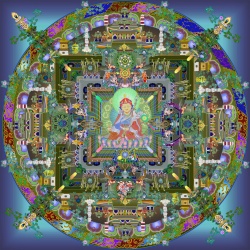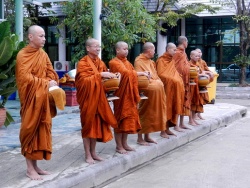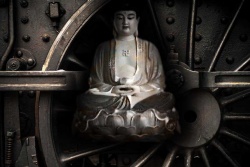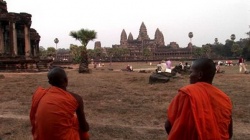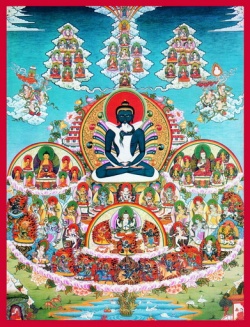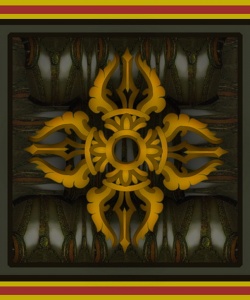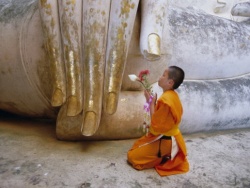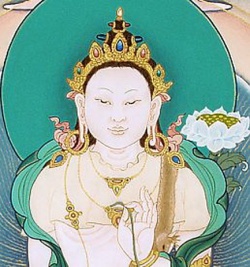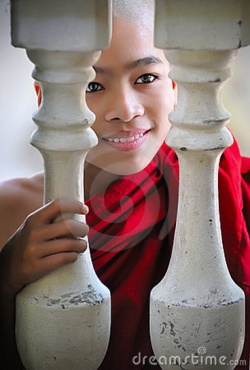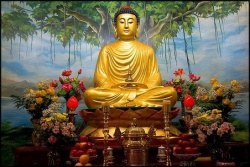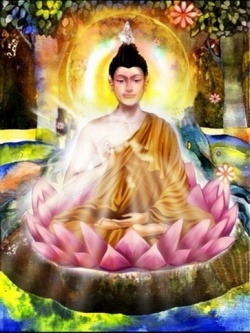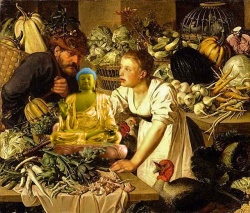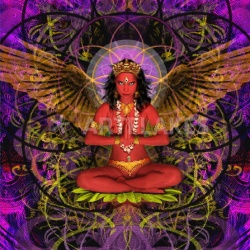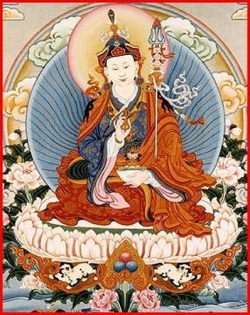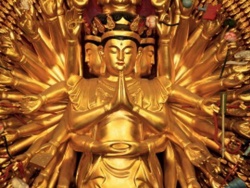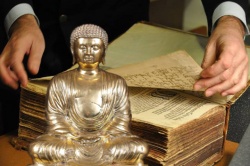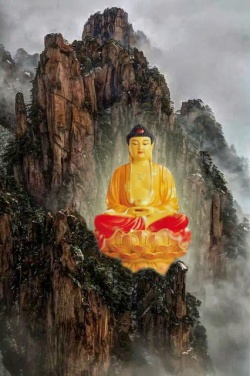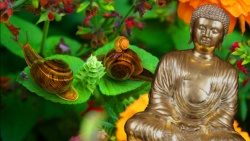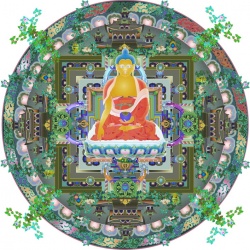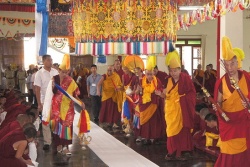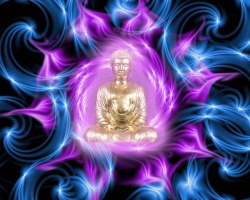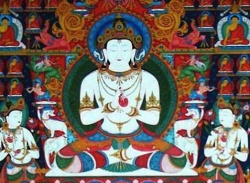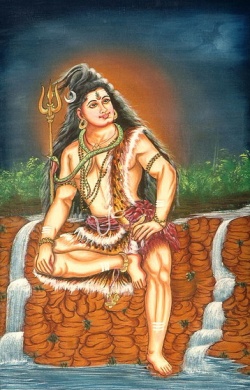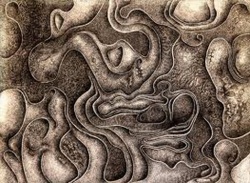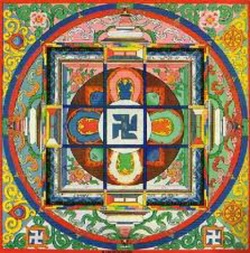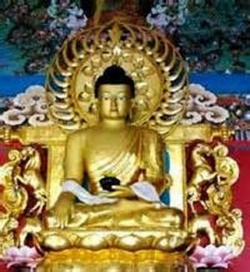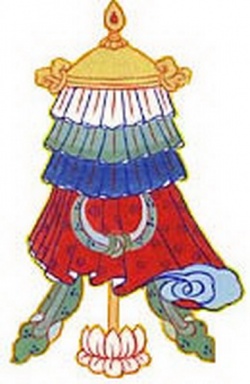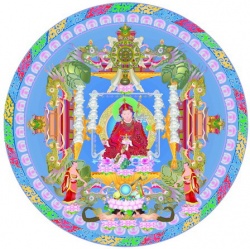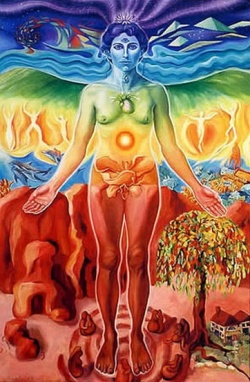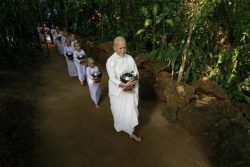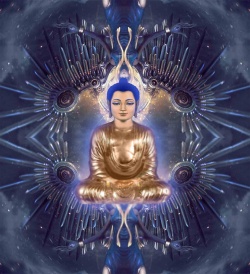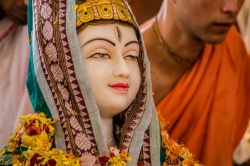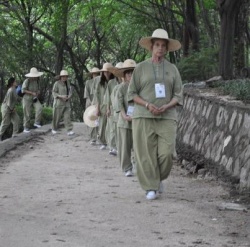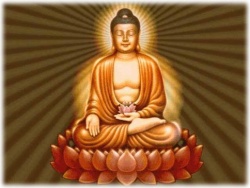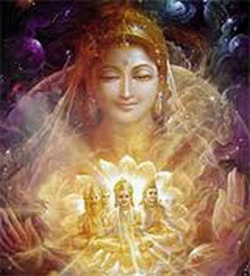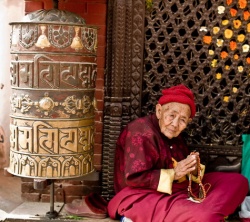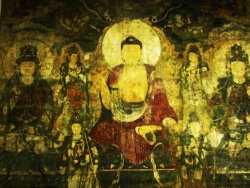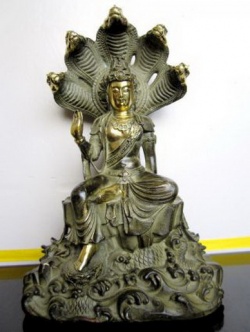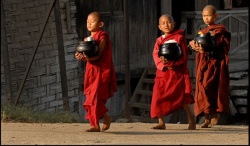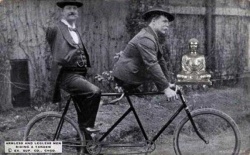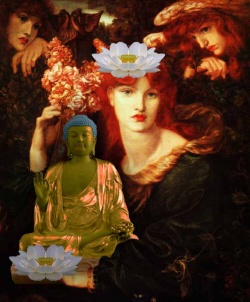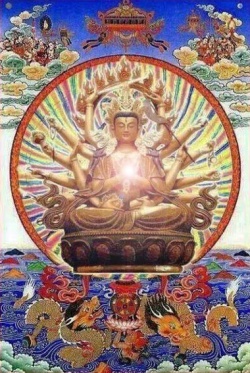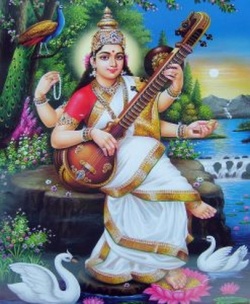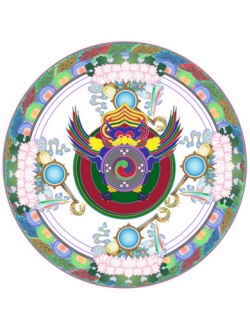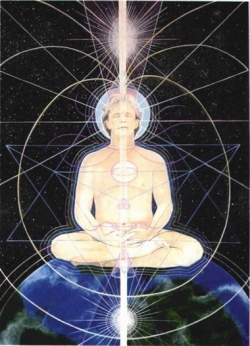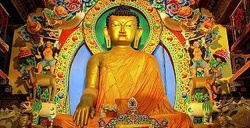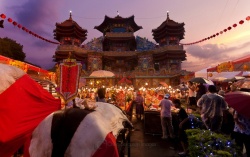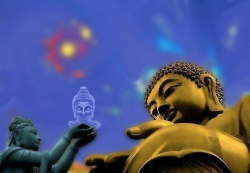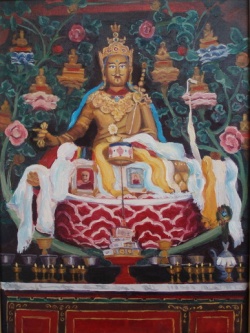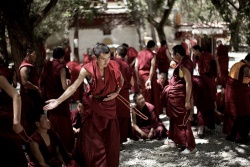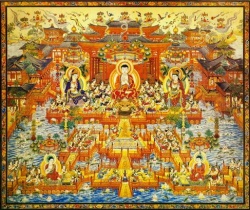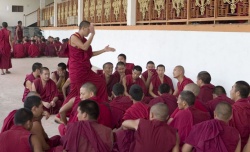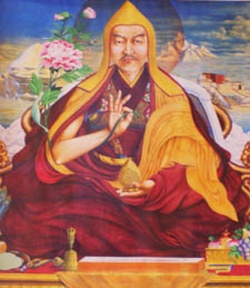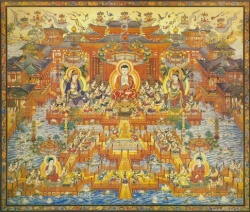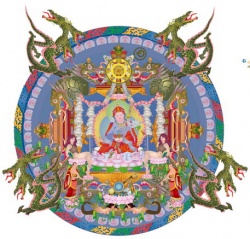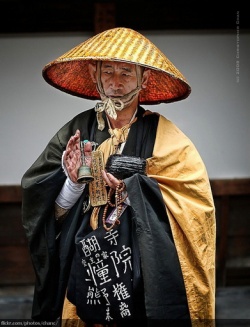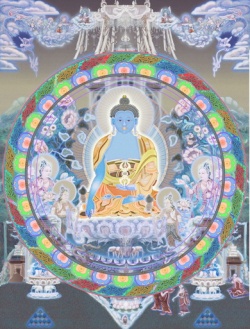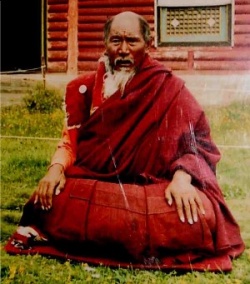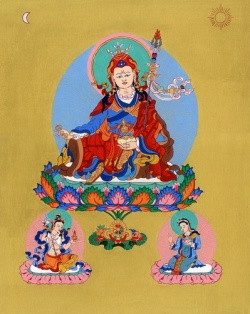With robes and bowl preamble: The Bhikkhu Life - The Thirteen Austere Practices The Triple
<poem>
WITH ROBES AND BOWL he Bhikkhu Life - The Thirteen Austere Practices The Triple
~~~~~~~~~~~~~~~~~~~
PREAMBLE:
The Bhikkhu Life -- The Thirteen Austere Practices
The Triple Gem or the Three Precious Ones are the highest ideals
of the Buddhadhamma. To the Lord Buddha, to the Holy Dhamma (Teaching)
and to the Noble Sangha (Order of Monks) are given veneration by all
Buddhists since they aspire to mould their lives according to the
qualities represented by these three ideals.[*]
* [See 'The Wheel' No. 76: The Threefold Refuge, by Nyanaponika Thera.]
In the English language, there are now a number of books
describing the life of the last Buddha, Gotama, also many explaining
what is meant by the ideal of Buddhahood. Likewise, we have an
ever-growing flood of literature, translations, commentaries and so
forth, to help us understand what is Dhamma. Much less information,
however is to be found on the Sangha, especially upon the bhikkhu-life
of the present day. Of course those living in the Buddhist countries
where the Sangha is established, will know more about it than will
those who follow the Buddha's Path in other lands. It is to give the
latter a picture of bhikkhu-life that this book is written, besides
keeping before the eyes of those living in Buddhists lands, the best
traditions of the Sangha.
While Buddhadhamma is a way for everyone, bhikkhu or lay-follower,
naturally the bhikkhus, since they have fully devoted themselves to
its practice, have more opportunity to penetrate to the heart of the
Teaching. To do this, they must, as indeed anyone who wishes to do so,
obtain experience in its three trainings (//ti-sikkha//): Learning
(//pariyatti//), Practice (//patipatti//) and Penetration
(//pativedha//). These lead on one from the other, thus making both of
the first two necessary. Without Learning, one's Practice (of keeping
the Precepts, Meditation) is liable to stray away from Correct
Understanding (//samma-ditthi//). Without Practice, learning is just
barren as far as the fruits of Penetration are concerned.
Commentaries written later upon the ancient Buddha-word give new
names to Learning and Practice, calling the former Book-work
(//gantha-dhura//) and the latter Insight-work (//vipassana-dhura//).
It may have been already in early times that a tendency appeared to
concentrate upon either one or the other as though they were
alternative ways rather than complementary steps. This tendency, which
has persisted into the present, seems to be an expression of human
frailty, for it is much easier to study the scriptures and become
learned,[*] while largely setting aside the practice, especially
meditation, than it is to get down and practice all that has been
learnt.
* [For the life of the `book-work' bhikkhu, see Buddhism, Ch. V.3
edited by R. Gard.]
This separation is however, far from absolute since many bhikkhus
gain a groundwork of Learning and then leave the city temples where
they have studied for a Meditation Teacher's forest dwelling, there to
take up the Practice which will lead, in due course, to Penetration of
the Dhamma.
Although one may gather something of the life of the Insight-work
bhikkhus from ancient sources, nothing seems to have been written
regarding them in the present day. Hence this short account which
attempts to outline their life as found in Thailand (the position in
other Buddhist countries is unknown to the writer).
A bhikkhu undertaking Insight-work bases his life upon the three
great foundations. These are: strict observance of the //Rules of
Training// (as contained in the Vinaya-Discipline) which he has
undertaken to keep at the time of his Acceptance (the higher ordination -- Upasampada). He is one who takes the earnest exhortation
of Lord Buddha to heart:
"Devoted to virtue should you dwell, O Bhikkhu,
devoted to the discipline of the Sangha and
restrained by that discipline! Perfect should be
your conduct and behaviour! Seeing danger in even
the slightest fault, you should train yourself in
the rules which you have accepted."
Secondly, he follows his Meditation Teacher in the application of
the //Austere Practices// (//dhutanga//), being guided by him as to
how and to what extent he should practise them. The first foundation
above ensures purification and the removal of obstacles while the
second gives rise to strong renunciation and to contentment with
little. Thus both become good, indeed necessary, bases for the third
foundation of his life, the actual Meditation Practice (//bhavana//).
Something should now be said about these Austere Practices.[*]
Lord Buddha refused to allow extreme asceticism, with which he had
experimented before his Enlightenment. However, he did recognize that
a certain degree of austerity would be useful in the training of
bhikkhus. For instance, we find that in the Four Nissaya (supports)
recited to a bhikkhu upon the occasion of his ordination, he is to:
(1) wear rag robes, (2) eat almsfood, (3) dwell at the foot of a tree,
(4) have fermented cow's urine for medicine.
* [Fully described in the `Path of Purification' (//Visuddhimagga//),
Ch. II.]
Further, we see from the lives of many bhikkhus in the time of
Lord Buddha that the Dhutangas were widely practised, for the early
Sangha was a community in which the wandering, meditative life was the
normal one. As examples we have the greatly venerated Maha-Kassapa who
was acclaimed by Lord Buddha as the foremost among those who lead
austere lives; while the first of his disciples to gain insight into
the Dhamma, Anna Kondanna, dwelt secluded throughout his life in the
depths of the forest.
With the establishment of permanent viharas, which began even in
the Lord Buddha's days, together with the necessity of preserving the
Buddha-word, memorizing and learning came to have increased
importance. Not all learned bhikkhus practiced and thus Dhutangas were
left for those who wished to practice meditation.
It was also stressed that for a person whose character was
strongly rooted in hatred (//dosa//), these Austere Practices would
not be appropriate, being liable to increase self-hatred. On the other
hand, with characters rooted in greed (//lobha//), faith (//saddha//)
and mixed-rooted (so-called `balanced') characters, the dhutangas
could help greatly in the cultivation of renunciation and contentment.
The differences between a thudong bhikkhu and one who practices
severe asceticism (some yogis in Hinduism, some Christian monks, etc.)
are worth noting. The latter start with some species of view that
there is a permanent spiritual entity (//atman//, soul) enclosed in,
or even imprisoned by, the fleshly body begotten of and begetting
further the so-called `lusts of the flesh.' Holding to such a view,
the body becomes something despicable and then hateful as it seems to
thwart one's search for the spiritual. Then follows `mortification of
the flesh' to quell the evil arising from the possession of such a
body (see for instance, the case of Henry de Suso (Heinrich Seuse)
related in William James' //Varieties of Religious Experience//). Such
attempts to `control' desires are really only extreme examples of
repression effected by means of self-inflicted torture. To begin to do
this, one must hold a view which hates the body and the outcome of
such asceticism will be greatly increased body-hatred. Masochistic
tendencies, where present, will also be gratified. All this can hardly
be said to indicate a healthy psychological state and Lord Buddha has
many times criticized these ways as unskilful (//akusala//). His words
found in the Dhammapada (verse 304) show the insufficiency of
`exterior' asceticism, which must fail to accomplish salvation.
"What is the use of your matted hair, O witless
man! What use your garment of antelope's hide?
Within you is a tangle (of passions); outwardly
you clean yourself."
In Buddhist Teaching, the inter-dependence of mind-body
(//nama-rupa//) is emphasized. Moreover, it is the mind which has
charge at the helm, while materiality (//rupa//) is a passenger. As
the Dhammapada stresses in its first and second verses: "Mind precedes
all states and is their chief, they are all mind-wrought..."
A Buddhist knows that he has acquired his present body through his
own craving (//tanha//) and that it is in the //mind// that one must
look to find the source of all unskill including all types of greed
and all hatred whether for self or other. The Dhutangas are therefore
a mainly physical discipline with a psychological basis and are
invaluable as a complement to the greater part of the Dhamma which is
a psychological discipline based on materiality (i.e., the
`possession' of a human body). The thudong bhikkhu thus makes use of
these practices in so far as they help him to discipline himself in
the promotion of skilful mental states like renunciation and
contentment.
These thirteen Austere Practices allowed by Lord Buddha [*] have
been characterized as a moderate and sane ascesis; they are as
follows:
* [The //Buddhist Dictionary// notes: `These 13 Ascetic exercises are
all, without exception, mentioned in the old sutta texts but
never in one and the same place; Majjh. 5, 112; A. v, 181-190"
Niddesa has 8 of them at M. Nid 1, p.188 P.T.S. edn.]
I. Refuse-rag-wearer's Practice (//pamsukulik'anga//) -- wearing
robes made up from discarded or soiled cloth and not
accepting and wearing ready-made robes offered by
householders.
II. Triple-robe-wearer's Practice (//tecivarik'anga//) -- Having
and wearing only three robes and not having additional
allowable robes.
III. Alms-food-eater's Practice (//pindapatik'anga//) -- eating
only food collected on pindapata or the almsround while not
accepting food in the vihara or offered by invitation in a
layman's house.
IV. House-to-house-seeker's Practice (//sapadanik'anga//) -- not
omitting any house while going for alms; not choosing only to
go to rich households or those selected for some other reason
as relations, etc.
V. One-sessioner's practice (//ekasanik'anga//) -- eating one meal
a day and refusing other food offered before midday. (Those
Gone Forth may not, unless ill, partake of food from midday
until dawn the next day.)
VI. Bowl-food-eater's Practice (//pattapindik'anga//) -- eating
food from his bowl in which it is mixed together rather than
from plates and dishes.
VII. Later-food-refuser's Practice (//khalu-paccha-bhattik'anga//)
-- not taking any more food after one has shown that one is
satisfied, even though lay-people wish to offer more.
VIII. Forest-dweller's Practice (//Arannik'anga//) -- not dwelling
in a town or village but living secluded, away from all kinds
of distractions.
IX. Tree-root-dweller's Practice (//rukkhamulik'anga//) -- living
under a tree without the shelter of a roof.
X. Open-air-dweller's Practice (//abbhokasik'anga//) -- refusing a
roof and a tree-root, the practice may be undertaken
sheltered by a tent of robes.
XI. Charnel-ground-dweller's Practice (//susanik'anga//) -- living
in or nearby a charnel-field, graveyard or cremation ground.
XII. Any-bed-user's Practice (//yatha-santhatik'anga//) -- being
satisfied with any dwelling allotted as a sleeping place.
XIII. Sitter's Practice (//nesajjik'anga//) -- living in the three
postures of walking, standing and sitting and never lying
down.
It will be noticed that the dhutangas help a bhikkhu to find
contentment with the first three of his Four Requisites (//paccaya//):
Robes (No's I, II), Almsfood (III-VII) and Shelter (VIII-XIII); the
fourth of his Requisites, not covered here, is Medicine.
As regards their present practice in Thailand, III, V, VI, and VII
are most commonly found amongst thudong bhikkhus. Having and wearing
only three robes is also widely practised (II). Individual thudong
bhikkhus may gather rags, stitch them together, dye and then wear them
although made-up robes are so plentiful that this not so common (I).
The fourth practice is the normal kind of almsround in many Thai
villages where every house gives a spoonful or so of rice to every
bhikkhu.
In the towns, IV is not practised, it being more usual for
bhikkhus to have a few houses where he is invited to call each day. All thudong viharas comply with VII. The next two are practised subject to the conditions of the weather for fierce sun or torrential rain make them both impossible. The eleventh may be recommended by a teacher for the practice of some of his disciples according to character while XII is a special aspect of that contentment which all bhikkhus must cultivate.
The last Dhutanga has been mentioned below as
a communal practice in some viharas upon Uposatha-day. When a bhikkhu practises this individually, he will usually only do so after consulting his teacher and, lest conceit arise, he will take care that others do not know that he practises in this way. It is likewise true of all these practices that they are to be undertaken in seclusion and a real thudong bhikkhu always shuns the public gaze. The //Buddhist Dictionary// says, quoting the Puggala-pannatti: "These exercises are however properly observed if they are taken up only for the sake of frugality, of contentment, of purity, etc."
The Thai word `thudong', however, has a rather wider connotation than that of these practices themselves. It is applied to anything connected with them and thus we have: thudong-vihara, thudong-bowl, thudong-life and so on. As the Dhutangas may be practised either strictly, middlingly, or mildly according to the standards laid down in the //Visuddhimagga//, so there are many variations in thudong practice and different teachers place different emphases and therefore different viharas have different conditions. For 2500 years and more, this thudong life has been lived by bhikkhus in many different lands. Not much can be found to record their life since those who take the thudong way are not usually writers and carry out their practice in seclusion. In Thailand, many of the ancient records, religious and secular, were destroyed in the conflagration of the capital Ayuthaya in 1767 CE. Still, we know that there were before that time, many Arannika (forest-dwelling) bhikkhus. Probably our oldest records now are the temple wall paintings from the early reigns of the present dynasty. They illustrate thudong bhikkhus undertaking the thirteen practices according to the three grades of strictness. At the present time there are a good number of viharas where this way of life with its three foundations is taught by experienced teachers. Most of them prefer to be well away from the commotion of city life, the distractions and luxuries of which are far removed from the thudong ideal. Finally, it is interesting to record that a large stupa (or cetiya, -- `relic-monument') with thirteen white pinnacles piercing the blue sky, is now being completed in a large thudong vihara named after that great Indian monarch who helped in widely disseminating the Buddha's Teaching, the Emperor Asoka. In the topmost cetiya will be enshrined relics of Lord Buddha whose life was this very thudong way, while below will be placed the ashes of a famous meditation teacher who had followed his Great Master's way with devotion, until his recent death. DAILY LIFE Control of the senses, contentment, restraint according to the Patimokkha and association with friends who are noble, energetic and pure in life, these are the very basis of the holy life for the wise bhikkhu. The bhikkhu who abides in the Dhamma, who delights in the Dhamma, meditates on the Dhamma, and who bears the Dhamma well in mind, does not fall away from the sublime Dhamma -- (Dhp. 375, 364) It is rather difficult to write about the thudong bhikkhu's daily life as the conditions in which they live are so different. However, there are certain features of this life which are general and these may be taken as a basis for this outline. The material which is presented in this and succeeding sections is composite in origin, some of it being experience heard from others and more again being stories told of others. Therefore we shall speak of `the bhikkhu' or `our thudong bhikkhu' and present all these varied sources under this anonymous label. While doing this, it should be borne in mind that much of what will be said is quite common experience for those following the thudong life. Wherever the thudong bhikkhu is, whether in a cave, in the forest, or in some other solitary place, his day begins early and with stirred-up vigour he rises. All is quiet except for the night-sounds of some insects and perhaps the swishings of bats -- and at such a time, long before dawn, say two or three o'clock, conditions are excellent for the practice of meditation. Of course, our bhikkhu, unless he is very skilled, will have to shake off Mara, (the personification of evil) in the guise of sloth-and-torpor (//thina-middha//), for this aspect of the Evil One would urge him to loll abed until daybreak. Instead he rises and after refreshing himself, fixes his mind upon his meditation- subject which he had put down the night before upon going to sleep. Making the triple prostration to the Three Jewels, quietly intoning, "Namo tassa..." and perhaps the Three Refuges, the bhikkhu, his mind rightly directed and guarded, settles into his meditation.
The extent to which he is able to fix his mind upon his subject, to prevent the arising of the five hindrances [*] (//panca nivarana//) and make it more and more
one-pointed, will depend of course upon his own progress and ability. The two greatest obstacles which he will encounter will be the sloth-and-torpor already mentioned above, and distraction (//uddhacca//); and between these two his mind is liable to vacillate as Odysseus' boat dodging between Scylla and Charybdis. Being wrecked upon one or the other will be a common experience for him in the beginning. When he finds his mind to be like a fountain bubbling up ideas, phantasies, memories, anticipations and so forth, he sits firmly upon his seat unmoving employing mindfulness (//satipatthana//) until the mind becomes quiet. But when sleepiness creeps into his mind and interferes with his bodily posture, then he gets up and practises his meditation while walking up and down.
If he is settled for some
time in a cave or in the forest, he will have made his walking place (//cankamana//) even, and neither too long nor too short. Pacing steadily up and down, sleepiness leaves both the mind and body and after some time, with the mind made one-pointed, he may try standing practice. After bringing the mind to a fully quiet and one-pointed condition in this position, he may return to fruitful practice sitting-down. * [See THE WHEEL, No. 26: The Five Mental Hindrances.] His practice will be concluded when the cockerels, birds or alarm-clock inform him that daybreak is at hand. Then, if he has them, he will offer a candle and a few sticks of incense and, having reverently prostrated, our bhikkhu will intone his morning puja to the Buddha, Dhamma and Sangha. The standard formulas for this, found so many times in the Pali Canon, gain deeper and deeper meanings which become clear to him as his devotion (//saddha//) deepens and as his practice makes progress. Indeed, when our bhikkhu's calm is well established, the slowly chanted phrases do not disturb at all and they may even be the basis for insight (//vipassana//).
He may supplement
these standard chants with others selected according to individual preference or tradition: among the latter will be the meditation chant upon the 32 Parts of the Body, the Pali of each repulsive part being followed by a translation into his own language, just to make their significance quite clear. This may well be balanced by the meditation chants of loving-kindness (//metta//), first filling himself with this spirit to get rid of inward conflict and then spreading out his loving kindness to other beings. [*] It is also usual to chant the Recollection-before-use of the Four Requisites of a bhikkhu (robes, almsfood, shelter and medicines.) The reason for doing this is that the true purposes of the Requisites then readily come to mind during the day when he is actually using them.
sincere wish that the merits which have accrued through this chanting, be made over for the good of all beings. Perhaps, being in Thailand, he may use the beautiful, "//Ya devata santi viharavasini...//", even more excellent when intoned in the rising and falling `//sarabhanna//' style of chanting. This chant is now beloved in Thailand since apart from the merit of its meaning and the euphony of style, it was composed by the greatly respected and deeply religious king, Phra Chom Klao, known to the West as King Mongkut (reigned C.E. 1851-1868). * [For many of these chants see THE WHEEL No. 54: The Mirror of the Dhamma.] Now is the time for our bhikkhu to prepare himself to obtain that medicine which will allay but not cure the greatest disease -- hunger. He will see that his bowl is in order, clean and tightly bound in its sling. Then rolling his two upper robes together (uttarasanga and sanghati), he is ready to set out. A few remaining possessions may be secured by him in his bag and hung up in some safe place to await his return; however, his three robes should go with him since in ancient days cloth was not always easy to obtain and even now the double outer `cloak' (sanghati) is expensive to make and must thus be guarded carefully. Many things may happen on his almsround (//pindapata//), the subject of another booklet in this series. [*] His almsround is not only to collect food for himself since it serves two other important aspects in Buddhist life. On the one hand he gives lay-people a chance to make merit (//punna//) by their acts of giving, while on the other he trains himself in many good qualities at this time, for as he goes his way collecting food, so he cultivates humility, loving-kindness and compassion, mindfulness and perhaps his meditation subject. * [See THE WHEEL No. 73: The Blessings of Pindapata.] Having taken sufficient food to last the day and knowing at the same time moderation in quantity, the bowl has then to be washed and dried carefully so that it will not rust, returned to its sling and tied to its stand, being then ready to be taken anywhere. If the bhikkhu is temporarily resident in one place, he will then engage in some walking up and down. This is in accordance with one of the discourses of Lord Buddha which recommends this form of meditation exercise to ward off sleepiness after having taken what is usually a substantial meal. Having thus established himself once again in mindfulness, he may take up any work which has to be done. It is difficult to list all the possible jobs that he may do at this time but readers should realize that he tries to be as self-sufficient as is practicable. Even though he has but few things (see section on "Wandering"), these have to be kept in good repair.
For instance, it
is important for him to keep his robes mended. Going through jungles, thorns catch and tear and there is always ordinary wear and tear; in fact, the thudong bhikkhu is well aware of the household truth -- `A stitch in time, saves nine.' A thudong bhikkhu's robes are usually well-patched and look as though they have seen long service. Or he may make certain things from bamboo or wood, and many a thudong bhikkhu is very skilful at such manufacture. A bowl-stand is needed or the bamboo shafts of his //crot// (umbrella-cum-mosquito-net) must be replaced, or he may make quantities of toothbrush-and-picks out of bitter wood to give to other bhikkhus.
Our bhikkhu may be conversant with the
medicinal properties of the herbs, trees and climbers which grow all about him, and compound from these, with honey, milk, red peppers and fruits, medicines for many diseases. Then again, he may manufacture out of tins, wire and fine white cloth, a collapsible candle-lamp which no wind can blow out; or perhaps he is gifted in the ability to carve and if so he may fashion small pieces of hardwood or ivory into images of Lord Buddha. He may, if he lives in a cave, like to adorn the mighty walls of his residence with drawings of the Buddha all executed in simple colours from the earth round about. If there were many thudong bhikkhus in this world, they would truly be the bane of modern commerce which insists that man's happiness depends on having many things and that he buys them in particular and new brands, from others. Quite contrary to all this is the thudong bhikkhu, whose ways are directly set against the worldly stream where it is not a multitude of things impermanent which bring happiness -- but contentment with little. Thus lightened of the clutter of things he goes more swiftly towards his goal of Enlightenment. Or, if his pindapata has been long and his food got with difficulty, he may feel bodily tiredness and lie down mindfully. This is usually done by lying on the right side placing a supporting roll of robes (or pillow if he has one) under the upper half of the body, the head being supported in the palm of the right hand while the elbow of that arm rests on the ground. This was the lying posture recommended by Lord Buddha and balanced thus, it is not possible to go to sleep while mindfulness will be maintained. Whenever he feels that his body is light, all tiredness gone, we should picture our bhikkhu sitting down cross-legged upon his sitting-cloth and arousing mindfulness and all the other salutary factors of meditation, and then striving to succeed, or perhaps succeeding in his subject of meditation. He may sit for many hours at a stretch especially if he is skilled, or he may vary his sitting with more walking and even, if his back becomes tired, with lying down. The latter posture can only be practised during the day as sleep is liable to overcome him if he lies down during the hours of darkness. He may also find it helpful in moments of mental stress or when he is experiencing too much of the monkey-mind. His meditation time will take him round to early evening when, the heat of the day over, it is the usual time to do the sweeping. If he lives in a meditation-vihara there may be large areas to sweep. If in a hut in the forest, then only his hut and its surroundings. But this work is quite unnecessary for one who is living under his crot wherever he has pitched it and he will probably not have a broom anyway. General mindfulness at this time is accompanied by the `sweeping reflection':
Just as this broom is sweeping away dust, so
may this meditation practice sweep away the defilements (//kilesa//). There are some other excellencies to sweeping: for instance it is a chance to test the strength of the calm (//samatha//) which has been developed mostly in the sitting posture. Also it is good exercise for the body after sitting still most of the day. Our bhikkhu does his sweeping rhythmically and silently. Next comes the time for bathing, perhaps in a forest pool or river. Taking his bathing-cloth our bhikkhu goes -- not with the worldly idea of enjoying the water but bearing in mind an aspect of his body's repulsiveness which makes it necessary to bathe. He reflects: having got this body through craving (//tanha//), one has daily to wipe off the sweat which oozes out of it, and the dirt which sticks to it, otherwise if would quickly become evil-smelling and unbearable both to oneself and to others. This also applies to his robes which require washing frequently while at this time he may occasionally have to dye his robes. Returning, still bearing his meditation-subject in mind if he is able, there may be some allowable drink awaiting him at his abode to refresh him further. Nains (novices) are expert at preparing these from jungle fruits adding sugar or honey, while if hunger disturbs him much, one of the bitter fruits allowed in the Vinaya may be taken with salt, sugar and perhaps some chili. Before he takes these, he will reflect carefully upon the real reason for doing so, according to the passage repeated in his morning puja. If we were watching him, we should soon notice the care that he takes so that no small creatures come to destruction. Before he pours out his drink, he inspects the glass to see whether ants or other insects are inside. If there are, he removes them very gently to a safe place. In lifting the glass and putting it down, he takes the same care and even when a mosquito alights on his body, it is not squashed but blown away for even the smallest creatures must not come to death either through his intention or through negligence. Harmlessness (//ahimsa//) has for him many practical applications. The time has come now for his evening meditation and taking his seat refreshed in body, he makes further endeavours in governing the mind. Perhaps before he begins, Lord Buddha's oft-repeated exhortation comes to mind: "What a master can do for his disciples, wishing them well, out of compassion and sympathy, that I have done for you. Here, O bhikkhus, are the roots of trees and secluded places. Practice meditation, O bhikkhus! Be not negligent lest you regret it later! This is my exhortation to you." And so we may imagine him sitting long into the night, as long in fact, as he can keep off sleepiness. When this becomes too pressing, he lights a candle and some incense and begins his night chanting. If he knows much Pali, this may continue for a long while softly and steadily proceeding with that euphony peculiar to this ancient language. It is recorded in commentarial stories that the gods came to listen to the Pali chanting of those bhikkhus living in wild places, who had pure hearts. At last finishing, after again making over all merits for beings' happiness (for one should not have greed even for merit), he lies down mindfully bearing in mind his meditation-subject and the necessity of arising early to proceed with his practice. THE HAND OF DEATH Ere long, alas, will this body lie upon the earth, unheeded and lifeless, even as a useless log. (Dhp. 41) Living in sylvan solitudes is not always, alas, ideal, for dukkha must show its fangs from time to time to remind our bhikkhu, if indeed he needs reminding, that it is in a world subject to birth and death that he lives. Having got himself into the condition of being born, he and all other beings will surely die. This lesson he learned from close acquaintance for he recently lost a good companion. He was an intelligent young man recently ordained as a nain, one who would have been well capable of understanding the Dhamma. He was able to live the thudong life and to enjoy it to his profit -- a not inconsiderable combination of factors. His life ended suddenly when he was about twenty years old, for he fell over a forty-foot cliff and dashed his brains upon the rocks below. Our bhikkhu was the first person to reach the nain after having raced down a circuitous path. Little enough could he do. Telling another nain to run into the nearest village for a stretcher, he knelt beside his only other companion on the rocky hill where they lived. The nain's breathing still functioned but in great, irregular gasps. Blood, already clotted, oozed from the sundered skull and trickled from many other cuts and bruises upon the body, arms and legs. Death was near at hand. Taking a rosary from his bag, the bhikkhu opened one of the nain's hands and placed it there. It would thus act as a skilful object of touch (//phassarammana//), if the nain's touch-consciousness still functioned. After sprinkling him with cooling water, he began to intone the suttas (discourses) for protection (//paritta//). This he did so that there would be a skilful sound-object (//saddarammana//) upon which the nain's death-consciousness (//cutti-citta//) could be concentrated. Though he tried to chant steadily and evenly, to give confidence to the dying nain -- if indeed he heard him, his voice was not without trembling. The minutes drew on and after the opening salutation of "Namo tassa....", the Karaniya Metta Sutta (on loving-kindness), the Mahamangala Sutta (on the greatest blessings), and the Ratana Sutta followed each other. [*] As the closing words of the last sutta: "Sangham namassama, suvatti hotu (To the Sangha let us bow: May bliss abound!)" -- as these words were softly chanted upon the shimmering air, a last breath arose and gaspingly fell -- and the body was still. His good companion had passed on according to his kamma and as the bhikkhu earnestly vowed: May it truly be to a better state of affairs than this! After that, if only to relieve his own mind -- and who knows, perhaps his erstwhile friend could still hear him in his new condition -- he intoned further the Buddha Jayamangala stanzas with their refrain of: "By the power of this (truth) may you be endowed with victory and blessings." * [For these discourses, see Wheel No. 54, The Mirror of the Dhamma.] It is widely believed in Buddhist lands that merits (//punna//) are transferable providing that one has a compassion deep enough with others and a wisdom grown great. For the well-faring of the dead nain, his friend made over to him all and any merits which he might have accumulated, including those gathered by the recitation of these hallowed scriptures. * * * We take up the story again three days later when bhikkhus have gathered for reciting the traditional chants for the dead. The father of the dead nain has also arrived. The chanting is solemn indeed and rolls on sonorously through the tropic night, spreading its peaceful sound far beyond the range of the pressure lamps which light up but a small circle in the bamboo forest. Seated upon mats covering the ground lay-people listen reverently with joined palms (//anjali//), while the chanting proceeds. Our bhikkhu, seated with others upon some more mats, concentrates all his attention upon the chanting, making it proceed not from the throat but deep down from the heart. At its conclusion, there is some informal talk upon Dhamma especially regarding death and kamma and then more general conversation opens concerning what arrangements should be made. A westerner might notice, if one had been present, that although this ceremony roughly corresponded to a funeral service, no one was weeping, or even looking particularly sad -- and certainly not the father of the late nain.
Whatever tears there had been over his death,
they were long since over and quickly stopped by such Buddhist recollections as the fact that rebirth takes place according to kamma and that nothing of this can be changed by weeping. And again, the injunction to live in the present without attachment to the past which is irreclaimably gone. And the reflection that rebirth may already be accomplished and (it is always sincerely hoped) be superior in happiness to this state; would it not be strange to be miserable because someone else was now more happy than he was in this life? Putting aside all self-pity which makes for most of the tears at death, a good Buddhist concentrates upon the situation //now// and sees what can best be accomplished in the present. The conversation has turned to the customary presentation, in this case by the father, of robes (//civara//) upon the death of a relative. Sometimes ready-made robes are laid upon the coffin and received by bhikkhus as //pamsukula// (intentionally cast-off cloth); at other times, white cloth is similarly given to be made up into robes. The strictest practice and one which is followed by a few thudong bhikkhus is to take cloth which has been used as a corpse-wrapping and make this into robes -- this is a practice from the time of the Lord Buddha and such robes may truly be called `rag-robes.' [*]
Our bhikkhu wishes to benefit from the present
circumstances so as to obtain such a robe. The father of the dead nain has already bought about twenty yards of white cloth for pamsukula robes. This has then to be inserted into the coffin and then to be extracted at the time of burning. Later, our bhikkhu will cut it up and sew it to make traditional patchwork pattern and the robes that he makes from this cloth will ever remind him of death, by stains and smell for some time and for longer by the memory of how they were obtained. * Pamsukulik'anga (Refuse-rag-wearer's) Practice, the 1st Dhutanga -- see Preamble.] The next day, food being finished, our bhikkhu turns his attention to the large coffin which rests under some trees. Candles and incense, the Buddhist symbols respectively of Enlightenment and of the perfume of strict morality (//sila//), are burning round about. As he approaches the coffin, the smell grows stronger -- the peculiarly repulsive smell of a human body's decay, which spreads its sweetly sickening odours for many yards about. It is not without some apprehension of what he will see upon raising the lid that he proceeds, for he has read the descriptions of bodily decay as used for meditation purposes but reading does not satisfy him, the bhikkhu wishes to see for himself. Lifting the lid, he gazes within and is immediately and deeply impressed that these descriptions as found for instance in the Satipatthana Sutta, [*] are but poor substitutes for beholding the real thing. His companion in life was a handsome young man, even with his hair shaved off: this body which lay before him was quite as hideous as temple wall-paintings sometimes show and emphasized for him that words are quite inadequate for portraying such sights. * [See Wheel No. 19, The Foundations of Mindfulness.] So, the young nain with unblemished body and pleasing face died but three days before and now what does our bhikkhu perceive? His companion is certainly not there! This puffed, distorted, oozing mass, blueish in colour is not the man he knew! Nothing resembles him. Three days have sufficed to change everything. Gaining this insight and the perception of impurity in even living bodies -- what to speak of dead ones -- he continues with the work he has set out to do. The body is already covered by the stained robes of the late nain and the white cloth is laid over this. Having completed his work, he reseals the coffin to await the time of cremation.
As the lid is replaced so the
stench grows less but the whole experience has burned itself deep into his mind and will not lesson. Indeed, he may develop it into a fruitful meditation when he sees with inward sight his //own// body not only as liable to such a condition but actually experiences the body (not then `his' body) as //being// in such a state. Climbing back to his dwelling high above the forest, he muses: Where such a terrible sight as this can be found so soon originating from apparently pleasing conditions -- where such and worse can be found, what sort of world is this? Who will waste their lives after such a perception? Who will longer be deluded by the sugar-coating of the world's sense-attractions after seeing thus? Will they not rather sense the bitter pill beneath? Is this not the time to turn away from those conditions giving rise to the bitterness? Is it not the time to devote oneself to that Dhamma which is "lovely at its beginning, lovely in its middle course, and lovely at its ending"? Some such thoughts as these, our bhikkhu thinks. For those who can do more, this is the time to join those millions who have gone forth like our bhikkhu with robes and bowl, rejecting all that the world values, and seeking to reject both ignorance and craving (//avijja-tanha//), those twin conditions for bitterness, to win in the Dispensation of the Conqueror, that Enlightenment which he also won. So urges the Enlightened One: "Shed thou householder's finery, As coral tree its leaves in fall: And going forth in yellow clad, Fare lonely as rhinoceros. And rid of passion, error, hate, The fetters having snapped in twain Fearless when as life ebbs away Fare lonely as rhinoceros." THUDONG ABODES The bhikkhu who has retired to a solitary abode and has calmed his mind and who comprehends the Dhamma with insight -- in him there arises a delight that transcends all human delight. (Dhp. 373) Our bhikkhu will live anywhere that is conducive to his practice of meditation and to winning insight but certain types of abode are generally more suitable for him than others. From ancient times a favourite dwelling-place of the thudong bhikkhu has been a cave, indeed this is really the best environment providing that a suitable one can be found. Not all are good for meditation and our bhikkhu upon arriving at a cave new to him would inspect it with the following points in mind. People are very fond of making caves into shrines -- and some of these are very beautiful with hundreds or thousands of Buddha-figures of different sizes ranged about the cave, sitting on blocks of stone and stalagmite near to the floor and gazing down compassionately from apparently inaccessible niches near the lofty roof. Such caves and others more rustic acquire fame as places of pilgrimage in proportion to their beauty and ease of approach.
Now, if our bhikkhu were to make
his sitting place in some such cave, he would surely be disturbed by the people visiting the shrine. Apart from the noise that they make, some would certainly approach him, perhaps trying to engage him in ordinary conversation, or coming to ask for charms or blessings, since popular ideas of `holiness' are rather less exacting or more vague than the freedom from the fetters (//samyojana//) which mark a Noble One (//ariya//) according to the Pali Canon. Therefore, if he does not wish to instruct in Dhamma, much less to engage in worldly matters, he will avoid all such caves. Apart from people, bats are also fond of caves in the dark depths of which they live in their thousands. They also make their noises, cheeping and swishing about, but their noises are much less objectionable than is the smell of their dung. This is very good for growing plants but less agreeable to a meditator's nose. Usually, they will not live near to the cave entrance, especially if the sun comes in and so, other conditions being favourable, our bhikkhu may live there. Other conditions include sound and heat. In this noisy age, rackety iron boxes of various shapes travel over land, water and through the air and their sound is surprisingly hard to escape from. It is understandable therefore that caves adjacent to airfields, motorways or railways, will also be avoided. The great advantage of a cave in a tropical country is its equable temperature. Cool even on the hottest days of the hot season, and warm in the coldest nights of the cold weather, it is very favourable for a meditating bhikkhu. Caves which have wide openings to the south or west are therefore less suitable for the hot weather. Other inconveniences to consider are the danger of falling rocks and the presence of carbon dioxide. Also, it sometimes happens that earth godlings (//bhummadevata//) take up their residence in caves and not all of them will welcome a bhikkhu staying there as this will interfere with their pleasures. Indeed, there are stories of bhikkhus being evicted by spirits but there is at least one instance of an experienced bhikkhu (lately a famous meditation teacher in this country) who sat night after night in a cave defeating all the efforts of godlings to oust him. Our bhikkhu, if he is wise, seeks for the protection of any gods there abiding, when he first arrives at a cave. With gods giving their blessing to his efforts, meditation certainly becomes easier; while, if the opposite should occur, it may be impossible. Finally, a consideration of great importance: its distance from the nearest village. As most thudong bhikkhus go to collect alms every day and as bhikkhus are not allowed to store food, so a village must be within walking distance. How far this is depends upon the vigour and age of our bhikkhu. Half a mile or a mile's distance is desirable in any case being thus beyond village noises but it does happen that a cave otherwise ideal may be too far from the village for the bhikkhu to walk there and back. In this case the villagers will help the bhikkhu by taking their food out half-way. He may find that living in a cave is a little eerie at first and should any "fear, trembling or hair-raising" take place, no doubt he will at least remember the Metta Sutta (Lord Buddha's discourse on loving-kindness). Also well-fitted for recitation at such a time is the Discourse on the Flags (//Dhajagga Sutta//) where the medicines recommended for fear are the Recollections of the Buddha, Dhamma and Sangha. If our bhikkhu is still better read in the Pali Canon, he will remember the Discourse on Fear and Dread (//Bhayabherava Sutta// in //Majjhima Nikaya//) where Lord Buddha describes the way in which he trained himself to be mindful of fear while he was yet a Bodhisatta (Wisdom-being striving for Buddhahood). What sort of picture do we get of our bhikkhu in his cave? If he is staying long he will probably have built himself a bamboo or wooden pallet above which will hang his crot. To one side somewhere, hang his bag and candle-lamp. Near to him will be a water-flask and, if it is dark, possibly a torch. His bowl is placed securely on a flat rock while any robes which he is not using are folded up neatly upon his pallet. He is sitting quietly facing the direction of his head when laying down.[*] If one were to watch intently, it would be difficult to detect even breath movements in his body, swathed as it is in rather shabby patched robes of folded ochre. Above him, the roof vaults in great arches and mysterious hollows half-lit by the dim light. Steady and distant is the dripping of water which makes through long ages great columns slowly joining roof and floor. Sunlight filters through a leafy screen for a few minutes and is gone and perhaps a bee drones in but finding little of interest soon finds its way out. All is very still, very silent. * [Because if he has a small Buddha-figure or Dhamma-book, it will be placed respectfully near to his head.] * * * He who sits alone, sleeps alone, walks alone, who is strenuous and subdues himself alone, will find delight in the solitude of the forest.[*] (Dhp. 305) * [This verse summarizes the 8th Dhutanga Practice (//Arannik'anga//) -- see Preamble.] Caves are by far the best abode but they, especially ideal ones, are rare so that we should go on to describe something of the more common `home' of thudong bhikkhus -- the forest. The advantages of dwelling in the forest are several. First, there is much of it in many Buddhist countries. Then, as it is the sort of place where most men do not like to live (except they are secure and comfortable in a strong house), the thudong bhikkhu is not likely to be disturbed, not at any rate by his fellow-men. Like other thudong abodes, it conduces to contentment with little; also, it makes very necessary the development of metta or loving-kindness. [*] * [See WHEEL No. 7, The Practice of Loving-kindness.] Besides advantages, there are quite a number of possible hindrances to practice while forest-dwelling. For instance, metta is made rather essential by the presence of all sorts of potentially antipathetic creatures, the most dangerous of which are snakes. This is certainly emphasized in the Pali Canon by the presence of a special chant, the [[Khanda] Paritta]], in which the person chanting stresses that he has metta towards and does no harm to all creatures including four species of snakes. There is a little story to illustrate this. An old Buddhist nun was living in a small hut close to the jungle. Her hut had one doorway and she usually sat on the bamboo floor for meditation against the opposite wall. She was quite accustomed to see the tails of large lizards appear out of the thatch overhead where they lived. Occasionally they fell out but being quite harmless, they would scamper away quickly.
One day, hearing such a bump on her floor, she
opened her eyes but instead of seeing a lizard, there was an angry snake of the poisonous species coiling and uncoiling itself. Instantly recollecting the meditation on metta, she pervaded herself and the whole hut with this spirit. The snake which lay between her and the door and had been threatening to strike her now quietly coiled up and after a few minutes, slithered out of the doorway. This anecdote illustrates quite a common occurrence for one dwelling in the jungle: how a meditator can be brought into close proximity with the untamed animal world. Is it necessary to stress further the value of metta in such surroundings? While the power of Lord Buddha's metta was so great that he could calm the rutting wild elephant Nalagiri, there have been many thudong bhikkhus up to modern times who have lived continuously in the forest developing the Brahma-viharas [*] (the Divine Abidings -- in loving-kindness, compassion, sympathetic joy and equanimity), and with whom forest animals become friends. For the man who has love -- and no fear because no hatred -- of other creatures, those creatures will not fear him. In this connection there are a number of Jataka stories which tell of the Bodhisatta's life in the forest when, living in a hermitage, all manner of animals became his companions. * [See WHEEL No. 6; "The Four Sublime States".] Still, there do seem to be some creatures which do not respond so well to metta and therefore, returning to the case of our thudong bhikkhu, he will be wise not to spread his sitting cloth over the entrance to an ants' nest, nor to pitch his crot near places where stagnant water lies. Regarding the latter, he would be courting the attentions of vast numbers of hungry mosquitoes. The crot is an effective protection against but it can be hot inside while cooler air blows without. So if a place can be found fairly free of mosquitoes, at least during the day, our bhikkhu will abide more happily. As to ants, they come in all shapes and colours and a good range of sizes and mill about everywhere and our bhikkhu knows that it is safe to assume that all bite, so it is well to stay away from their roads, tunnels and doorways. A few drops of paraffin sprinkled round his sitting-cloth will ensure that he is fairly secure against invasion. Unless the forest is really ancient with dense shade, our bhikkhu will experience extremes of heat and cold unknown to the cave-dweller. In the hot season the sun blazes down from our of the cloudless sky overhead and the small shade of his crot will be insufficient. Even under a tree, at least in open forest, hot winds are liable to blow and make life less pleasant. [*] The conditions in densely-shaded rain forest rather resemble cave-dwelling but there is an increase of biting life to reckon with as well as the rainfall. * [The practice of the 9th Dhutanga (//Rukkha-mulik'anga//) is therefore possible at some places and times, See Preamble.] Forest-dwelling is only possible for the thudong bhikkhu all the year round, if he has a small hut to supplement the protection of his crot. [*] During the three months of the Rains Retreat (Vassa -- approximately July to September), he must in any case dwell with a roof over his head. It is quite common for thudong bhikkhus to have a small wood and bamboo hut built by a supporter in some favourable place in the forest and to dwell there either alone or with a nain or boy to assist him. * [Thus limiting the practice of the 10th Dhutanga, //Abbhokasik'anga// (Open-air-dweller's) Practice, to the dry season and cool places: see Preamble.] Forest life is very far from silent for, quite apart from the occasional noises of the larger animals, smaller ones, especially insects keep up an almost continuous racket. Cicadas and grasshoppery creatures although small, manage to produce incredible volumes of sound sometimes resembling that of railway trains! The only times when they are silent is when presumably they are sleeping. This is during the heat of midday and afternoon and during the middle watch of the night. Unfortunately this quietness coincides with the times when human beings also are most inclined to sleep. However, forest conditions vary very much and our bhikkhu will not find all the unfavourable conditions together, but since this world is one level of samsara, there are bound to be one or more flies in the ointment. We may think of him on a moonlit night in the hot weather. A cooling wind blows stirring the trees many of which are leafless, while filling the air with the fragrance of some tree's blossoms. A little bamboo hut stands raised upon wooden legs and upon its open platform a boy sleeps. The bhikkhu paces up and down his walk which is some thirty feet long and made under tall trees. The dark end of it is lit by his candle-lamp hanging from a tree while the moon lights up the rest. Light is necessary since thick, tubular millipedes have their homes on either side of his walk and also like to wander upon its smooth and freshly- swept surface. Our bhikkhu finishes his walking and contemplatively returns to his hut. Mounting the bamboo ladder to the platform, he stops before the door to his tiny room. Over the door is fixed a polished wooden board upon which the following words are cut and coloured: Handa dani bhikkhave, amantayami vo: Vayadhamma sankhara, appamadena sampadetha'ti. "Pay attention, O bhikkhus, I exhort you: Going to destruction are all compounded things, With heedfulness make an effort!" These are the last recorded words of Lord Buddha: his final exhortation to the thudong bhikkhus of those days. [*] * [See WHEEL No. 67-69, p. 75] For our thudong bhikkhu now they not only have the significance of being the last instructions, since his own practice -- and perhaps realization -- accord well with them. * * * `Should one find a sagacious man who points out faults and reproves, as if indicating a hidden treasure, let one associate with such a wise person. It is always better and never worse for him who cultivates the acquaintance of such a one. Let him admonish, instruct and shield one from evil; a dear one is he to the good, detestable to the wicked.' (Dhp. 76-7) The greatest teachers of the thudong tradition have very often wandered all their lives, never settling down long in any one place except for the annual Rains Retreat, or when extreme old age forced them to do so. Some have never founded viharas (monastic residences), leaving this to those of their disciples who had an aptitude for such work. Our bhikkhu, however, especially if he still requires guidance, may live in a thudong vihara. This will be rather different from the ordinary run of viharas where bhikkhus usually live two or three together in large huts (//kuti//), or even if they live singly, their residences will be crowded closely together being built about an open hall (//sala//). A thudong vihara is distinguished by having the huts set so that from one, another cannot be seen. This is not difficult as wood, bamboo and thatch blend easily into the jungle. In each hut, one bhikkhu lives and orders his time according to his practice and ability. Our bhikkhu will not often meet others resident there; once or twice a day at most. The first time is when all gather in the hall to prepare themselves for pindapata while the second may be in the evening when some fruit drink is served. At this time also, the venerable teacher of meditation may give some instruction, as he sees fit. General instructions, for instance on matters of Vinaya (monastic discipline), will be given to the community of resident bhikkhus every Holy Day (uposatha -- the Full and Half Moon Days) after the recitation of the Patimokkha (the bhikkhus' Fundamental Precepts). If our bhikkhu wishes for individual instruction in some matter, he will approach his teacher after the evening instruction has been given and, after saluting him with the triple prostration, he will question him respectfully. If we were present in the hall, pillared with roughly shaped tree trunks and lit by candles burning before the gilded and painted shrine of Lord Buddha, we should notice the great respect which he pays to his teacher.
He sits in a respectful position
never pointing his feet towards the teacher and he always raises his joined palms (anjali) when speaking to the teacher while, when the latter speaks to him, he places them clasped together in his lap and listens attentively. Our bhikkhu's teacher is for him one who has experienced some degree of the Dhamma in his own heart and not merely read about it out of books. Such teachers are therefore accorded great veneration and anyone going to such a teacher, yet not making the usual salutations, would probably be regarded as being difficult to teach -- because of the presence of strong conceit. [*] * [For an interesting case of this in ancient times see the "Sutra of Hui Neng (Wei Lang)" and the master's encounter there with Bhikkhu Fa-Ta.] In some thudong viharas, usually those inclined to less strict observance, there is communal meditation and puja in the morning before pindapata and again in the evening. Some teachers favour this while others prefer their disciples to lead a more solitary life. Both may be valuable to our bhikkhu according to his character and progress. Upon uposatha-nights it is also a feature in some thudong viharas, to chant Lord Buddha's discourses all through the night, the bhikkhus not sleeping. [*] This may be interspersed with some instructions from the meditation master and perhaps by the individual practice of walking. Where practice already goes deep, this chanting, slow and rhythmic, may well be an aid to attainment in meditation. * [This is a modification of the 13th Dhutanga (Nesajjik'anga -- the Sitter's Practice). See also Preamble.] Regarding this, there was once a twelve year old boy who sat down one evening with other pious lay-people who were practising meditation while the bhikkhus chanted. He knew nothing about how to practise, nor had he ever sat in meditation posture before. But a very great meditation-master lived there at that time and was leading the bhikkhus in chanting.
These factors all combining led that boy through
successive stages of mental concentration until he reached complete meditation (//appana samadhi//). He was still sitting rapt in stillness when the bhikkhus prepared to go collecting pindapata. The meditation-master upon seeing him, decided not unnaturally, that the boy would make a good disciple. After rousing him, and giving him the precepts, the boy lived in that vihara learning the way from his master. One bhikkhu, well-practised in meditation, was famous for the easy control he had over his body. Sitting down in the temple at eight o'clock upon uposatha-nights, he would not find it necessary to change his posture until six o'clock the next morning. He never got up from his seat, his gaze never wandered anywhere, he just concentrated upon chanting from the heart being completely absorbed in this. Our bhikkhu will be encouraged by his teacher to live with him until such times as the latter feels that he has sufficient knowledge of the Dhamma and strong enough meditation to go off on his own, to practise in a cave or forest. There are disciples who like to stay with their teachers until death parts them. There are others who want to go off quickly and practise alone. It sometime happens that the latter experience one of the ecstatic absorptions (//jhana//) and conclude from this, since they lack sufficient Dhamma-knowledge and the guidance of their teacher, that they have won a noble (//ariya//) attainment. Sometimes such bhikkhus proclaim this out of ignorance and gain quite a following: however, their fame soon dwindles for one cannot //pretend//, intentionally or otherwise, to be an Arahant (an Accomplished Sage), or even to have reached one of the lower stages of ariyan attainment. A famous teacher once had a pupil who esteemed himself to be an Arahant but the former knew that he was not so but that his mind was really overcome by the perversions (//vipallasa//). Now this teacher had another pupil who, although he could neither read nor write, had such experience of Dhamma that many consider that he was really an Arahant. He lived alone in a cave and seldom spoke and when he did so, he uttered only words of Dhamma, never mere pleasantries. The famous teacher was in the habit of sending any of his pupils who became deluded to this great pupil, of whom he thought very highly. So he sent his deluded disciple to him.
The first and only words which the
great pupil spoke to the deluded one, were: "Sit here." The former gave the latter no instruction, he only sat in meditation with him day and night only rarely breaking off for the barest necessities. After two weeks of this rigorous treatment, the deluded one at least gained the insight that he was not after all an Arahant and then returned to live with his teacher. In this way he was cured of this manifestation of the perverted mind (//vipallasacitta//). Living in a vihara, at least for some time, will enable the thudong bhikkhu to make his meditation practice grow strongly and that "fear, trembling and hair-raising" which he might easily experience in other more remote surroundings, are less likely to arise there. He has the guidance of the Good Friend (//kalyana-mitta//, as the meditation teacher is called), and the companionship of the good, that is of fellow-bhikkhus and nains who are likewise striving to accomplish the goal of complete liberation of the mind. In this way he has the best possible environment for progress in his meditation and may stay with his teacher for many years. This is particularly true if the pupil finds just the right teacher who can instruct him in the right way to go. For just as pupils vary as to the proportions of differing defilements in their characters, so teachers vary with regard to different attainments and ability. * * * `Just as a storm cannot prevail against a rocky mountain, so Mara can never overpower one who lives devoted to the meditations on impurity (of the body), who is controlled in senses, moderate in eating and endowed with faith and earnest effort.' (Dhp. 8) What can we say of other bhikkhu abodes? Generally the thudong bhikkhu looks with disfavour upon living on a mountain -- unless that is, there happens to be a village near and at approximately the same altitude. Our bhikkhu knows that his bowlful of rice is quite heavy enough, especially after a long walk, without having to haul it up a mountain path. Whenever bhikkhus ceased to rely on pindapata, as for instance in China, they were able to live upon mountain heights in peace and solitude. Among abodes recommended in the "Path of Purification" is the charnel-field or bone-yard. This is said to be an excellent abode for greed (//lobha//) characters. It appears to have been a common custom in ancient India to take corpses to a special part of the forest and to leave them there to go to their dissolution. Thus a thudong bhikkhu lighting upon such a place might be able to see all the various stages of decay of the body -- as they are described in detail in the above work. [*] Such was, of course, an unforgettable lesson upon the fate of his own body. * [See Ch. VI, "Foulness as a meditation subject." This is also Susanik'anga (Charnel-ground-dweller's) Practice, the 11th Dhutanga. See also Preamble.] Nowadays, in this country, bone-yards like this cannot be found, for burning the body sooner or later has taken the place of the natural process of its return to the component elements. Therefore it is now almost impossible to live in this environment and the best that can be done is to dwell near a burning ground. Usually there will not be much of bones remaining, only piles of ashes, still there is for many the fear of spirits (//peta//) to overcome. It is commonly assumed that such a birth follows a human one and that the hungry ghost or spirit lurks about near its former body, sometimes with evil
intent while others are supposed to be more kindly disposed. This may sometimes happen when peta-birth actually follows the human one because of peta-like kamma, but popular belief assumes that this is invariable. However this may be, a certain amount of caution is required before dwelling in such a place. If our bhikkhu is of imaginative disposition, he must have his imagination well under control before dwelling in a burning-ground. An uncontrolled imagination coupled with loneliness, the natural noises of the night and the dimly lighted surroundings can result in an unbalanced mind. A good many years ago now, there was a nain recently ordained and fifteen years of age. His meditation master sent him to dwell overnight in the local burning-ground-cum-graveyard which was well out of the village, in the jungle. Not knowing that it is proper to inspect such a place in full daylight first, noting how all the rocks, trees, tombs etc. are placed -- he arrived there only at dusk. After laying a cloth to sit upon and hanging up his crot, he began to look around. Finding a suitable place to walk up and down, he decided to begin his meditations in this way.
As he was turning round, at one
end, out of the corner of his eye, he saw a great black phantom looming up, its jagged arms outstretched, the claw-like fingers ready to seize him. In fear and trembling he continued his walking and so great was his terror of the unknown `thing' that he did not sit or lie down all that night but walked and stood meditating (with a glance every so often to see that `it' had not moved). When dawn came, the 'thing' became less black and menacing, slowly resolving itself into a stricken tree-trunk! As custom has changed so much that the boneyard is no longer to be found, there was in this country many years ago a senior bhikkhu who decided to remedy this lack. This teacher dwelt in a little vihara in a patch of woodland outside a small town and near the old capital of Ayuthia. Very few bhikkhus stayed in this vihara for after they had seen what they came to see, he sent them away to practice on their own. And what did they see? This teacher had constructed a flower garden and all round it he had built a high wall pierced by only one door and that was padlocked. The flowers that grew in this garden were very special ones, special bhikkhu flowers. The flowers of laymen are of gorgeous colours, entrancing shapes and subtle perfumes but these flowers for bhikkhus although they had their colours, shapes and perfumes, were rather different. Inside the garden there were constructed a number of open troughs covered by glass frames from one end of which rose a long pipe. When a man died in the town, the teacher would go and personally carry away the body, slinging it over his shoulder. Taking it to his garden he would lay it in a trough and cover it with a frame. When a bhikkhu desiring a subject of meditation came to him, he would be told by the teacher that he only instructed in the Cemetery Contemplations. At first the teacher would go with him into the garden during daylight and let him select a suitable `flower' for his meditations. Then he let the bhikkhu go in there alone, to fix the subject in his mind. Finally, he was permitted to go in at night and spend the hours of darkness meditating upon his `flower'. Then having settled the meditation subject firmly in his mind, the teacher would tell the bhikkhu to go and to meditate alone. Before he went, he would receive instructions upon a further aspect of the meditation which emphasized that it was not a body `out there' which was to be seen, even in the mind. It was his own body which had to be seen with insight as bloated, festering, or just dry bones, according to the stage of the decay selected. Thus were bhikkhus of that time enabled to free themselves from the deluded identification of this body as being `myself' or as `mine' -- by the special exertions of this teacher. Every teacher, as we have mentioned before has his own characteristic ways, both of instruction and of conduct. If our bhikkhu went to a certain teacher, a disciple of a yet more famous master, he would have to put forth energy if he wished to live with him. This teacher lived in a little ramshackle hut -- he would not let lay-people build him anything else, in a small jungle vihara -- and was about eighty-five years old. It was his practice to begin his working day at five o'clock when he would vigorously start to sweep the vihara grounds. Then, when it was light, he went out to collect food. Returning, he ate a single meal of small quantity and for the rest of the day drank only water. Besides the two normal pujas, he made a third one in the middle of the night. To do this, he slept from ten o'clock until midnight -- and never used a mosquito-net -- and then got up for puja, after which he slept again for another two hours. Arising vigorous, he would sit in meditation until the sweeping-time. His appearance was hale and it appeared that he might very well carry on with his way of life for another twenty years at least! Stories about teachers are endless and this short account could never contain a tithe of them. So we must let these few suffice as examples and close this section on thudong abodes. * * * WANDERING `Those who exert themselves and are mindful, delight not in any abode. They are like swans that abandon their like, leaving home after home behind.' (Dhp. 91) Today, when it is possible to go quickly everywhere by some conveyance or other, why wander? What is the purpose of the thudong bhikkhu who, alone or with one or two companions, prefers to go his way on foot? There are quite a lot of reasons why wandering in this manner is preferred. For example, the wanderer goes quietly and at whatever speed he wishes. He is not brought into contact with others who might disturb his contemplative way and he may stay at a place just as long as it pleases him -- and leave it when he wishes. Also, he is uninvolved with other people, no arrangements has he to make for them while he gives trouble to none. In fact, his is the way of freedom. Then again, he reflects that this way of travel was used by his great Master in the forty-five years of his teaching in India and has been that of countless other bhikkhus seeking Enlightenment. The modern ways of travelling are good for getting to places quickly but not so good for gaining Enlightenment. There is distraction enough in the mind without churning it up still further -- some such thoughts he thinks. Reasons for wandering are also rather various and we are only concerned with those motivated by the search for Enlightenment. The real purposes are threefold: to be able to dwell in solitary places for meditation; to visit meditation-masters who often stay far into the country or forest; or to go on pilgrimage to some famous shrine. While the first and second have already been touched upon, the third needs a few more words. By pilgrimage to a shrine is meant the desire that arises in some bhikkhu who has taken to thudong life, to visit and make his puja at a great stupa (reliquary monument) where are enshrined some remains of Lord Buddha or the Arahants. Or perhaps to go to some famous temple where an exceptionally beautiful image of the Enlightened One is enshrined. All this he does with the idea that merit is gained from such actions and indeed, if our thudong bhikkhu, or anyone else, goes on such pilgrimages single-mindedly and in deep devotion, the results for his own development in the Dhamma are bound to be fruitful. If he wanders every day, especially if the weather is hot, the way rough or both, his power of meditation must be very strong indeed, or it will suffer from the impact of these external conditions. Tiredness of the body after walking only four or five hours can be a great obstacle in the way of peaceful practice. Therefore, either he will walk one day and then finding a suitable place, stop there for three or four days, or, if he wishes to reach a definite place by a certain time, then he puts by his practice of mental calm (//samatha//) and takes up the full time application of mindfulness (//satipatthana//) in its various aspects. [*] * [For these see: Wheel No. 60, //The Satipatthana Sutta and its Applications// and, //The Heart of Buddhist Meditation//, Rider and Co., London.] Besides the necessity of strong samadhi, it is quite sure that he must have a strong body able to endure blazing sun, heat, sweat, rough ways, insects and cuts and bruises. These latter, together with blisters, are not infrequent in thudong life and can make his way very difficult. If he goes without sandals, rocks will cut and thorns pierce his feet, or going with them, the feet must be very hard or they will surely be chapped. Strength of body is required so that he can carry comfortably his few essentials. What does a wandering thudong bhikkhu carry? First of all, there are his eight essentials which are a bhikkhu's only possessions. They are: three robes (one waist-cloth, one upper robe and one double robe, [*] a bowl (usually of thin malleable iron with a brass cover), a waist-band to secure the waist-cloth, a needle and thread, razor (of cut-throat pattern), and lastly, a water-strainer. These items he //must// take with him or if he loses any of them at any time, they should be made good as soon as possible. In the thudong life, all these things have their relevance -- including the water- strainer which is a very important piece of equipment. * [Having only three robes is the Ticivarik'anga (Triple-robe-wearer's) practice -- the 2nd Dhutanga; see Preamble.] Besides these, there will be certain other things which he is sure to have: a water-flask or kettle, his crot, a sitting cloth and one for bathing and probably a bhikkhu-bag containing a few additional articles. Among these may be a candle-lamp, and or two medicines, toothpick-cum-brushes, perhaps a small folding clock and a penknife. He may also carry a copy of the Patimokkha (his Fundamental Precepts) in Pali with a translation into his own language and some small book on the teaching such as the Dhammapada. All these together make up a good weight and generally he will only want to carry them before the sun gets too high and the late afternoon or evening when it is setting. How then should we picture our bhikkhu as he makes his way by footpaths and stony tracks, through deep forest or open rice-fields? He wears two of his robes, the double-thick one being usually wrapped and stowed inside his bowl, unless it is very cold. His bowl is secured in its sling and tied tight to its stand, while the strap of the sling passes over one shoulder.
His sitting cloth and a few other
things may also be put inside while the bathing-cloth forms an additional outer protection for the bowl. His bag, the //crot// in its sling and the water-flask, hang from the other shoulder. A thudong bhikkhu does not wear his robes long but hitches them rather high and so passes more easily through streams and over mountains. If he is in open country and the sun is shining, he may place any handy piece of cloth on his head, although this is always removed in accordance with the Vinaya's injunctions when passing by houses or through villages. The sandals on his feet are stout ones -- they have to be to take all the knocks that his feet would otherwise suffer. In this way he goes, mindful of and joyful in the Dhamma. He may go alone or with a nain or small boy following, or he may be with one or two other bhikkhus. Probably they will not be walking very close together but prefer to be rather well-spaced so that mindfulness does not suffer, nor conversation tend to break up their silence. Every so often, at least in forests, one of the bhikkhus will spot some refreshing fruit tree and then they may turn in that direction and after gathering the wild fruits -- providing that it is not yet twelve o'clock -- sit eating them while taking a well-earned rest. Certain bitter fruits, such as the emblic myrobalan, may be taken after midday as they have medicinal properties and our bhikkhu will be glad of these to help quench his thirst in the heat of the afternoon. A few thudong bhikkhus //en marche// in some ways resemble a small detachment of soldiers. They both have uniforms, they both carry all their needs along with them and in both cases the senior leads and the juniors follow, but here the resemblance ends. The former wear the robe of peace, of harmlessness towards all living beings and all their possessions speak of a pacific way of life. No guns do they carry, but //crots//, no grenades, but almsbowls. The wandering bhikkhu has conquered eastern Asia by these means, without dissension, without resort to violence, without wars but with loving-kindness and compassion. And those mighty empires which ambitious and victorious men have raised one after the other, by the use of force, shattering opponents by wars innumerable -- all this might and glory has passed away, has crumbled to defaced stones and time-smoothed coins found in distant jungles. But the Dispensation of the Conqueror who practised and preached a morality based upon non-violence, this empire of peace has endured. What is the message here for the empire-makers, political or economic, of the present day? What has this Dhamma to say to those who think of their lives as a fight against others? Upon this matter, the Dhammapada has the following verse: Though he may conquer a thousand thousand men in battle, yet, he is indeed the noblest victor who would conquer himself. (Dhp. 103) Our wandering bhikkhu may decide at the end of his day whether he will stay the night in the forest, or cave or other suitable place, or whether, the country proving unfavourable, he will go to the nearest village. If he elects in favour of the latter, it may well be that in approaching the village in the evening light, some villagers will see him. Then some pious laymen will approach him and saluting him respectfully, relieve his shoulders of bowl and crot and invite him to stay for the night in the village vihara, or where there is no established residence for bhikkhus, in the `hall' (//sala//). Word will soon get round the village that a venerable thudong bhikkhu has arrived and people will then come to the hall bringing with them things for his comfort -- a pillow, mat and of course, tea. In Thailand at any rate, this means `water-tea' (literally translated), or as westerners would say, Chinese tea. He may also be offered honey or sugar to refresh himself and while he does this, people will sit upon a lower level of the hall and respectfully enquire where he has come from, whereto he will be going, how long has he been a bhikkhu (how many Rains-Retreats?) -- and so forth. If our bhikkhu wishes, or has the gift of teaching, the general conversation may well be turned towards Dhamma and the lay-people will sit listening intently and perhaps putting a question now and then upon some point which they do not understand. Whenever there is time during the informal gathering, or when people have departed, our bhikkhu will have to see about patching up his skin bag which is so liable to become punctured even though he takes great care. Villagers will give him more medicines, often of their own manufacture, if those he carries do not suffice. His various wounds, usually very small matters, may nevertheless give him plenty of room for reflection upon the nature of the body. A small pimple soon grows into a large sore and an insignificant cut quickly pulsates with oozing pus; and he remembers that each day he chants: "There are in this body -- //kesa// -- hair of the head, //loma// -- hair of the body ... and so forth, to... //taco// -- skin, //mamsam// -- flesh... //pubbo// -- pus, //lohitam// -- blood..." . His cuts and blisters are reminders for him that the bag of skin holds much which although usually hidden from ordinary sight, is liable to erupt and compel attention. The thudong bhikkhu gives attention here willingly whereas the worldly attitude is to turn away from and try not to consider such nasty things. Our bhikkhu, however, knows that the seeing of all these parts of the body, traditionally thirty-two in number, as they really are, that is, as a danger, as repulsive and as liable to decay, leads him towards freedom from the `own- body-view' (//sakkaya-ditthi//) and towards that state where the body is viewed quite impersonally and as a collection of processes, acting and reacting. At best, it will be seen, after insight into its nature has been experienced, as an instrument of the Dhamma. Towards such insight and mature understanding, our bhikkhu strives, and he will, if he has still energy enough, sit in meditation after the last villager has departed and, attaining calm, shift his attention to these thirty-two messy parts, or some one or two of them, endeavouring to develop insight. Perhaps he may vow before taking his rest: "Oh, may this body be devoted to the Dhamma, may it become a Dhamma-instrument." And his night will be spent peacefully, no dreams will disturb him and he will awake refreshed, the body ready for active service in the Dhamma when he takes up his meditation-subject again in the cool of the morning. When it is fully light, many villagers will come to the hall to make merit which means that our bhikkhu will not have to go out for pindapata. Every house will send a bowl of rice and some other food to accompany it and perhaps he may get sweets and fruits as well. One person from each house will place one or two spoons of rice into his bowl as it stands upon the raised platform-floor. When they have finished, the other food, together with his bowl will be reverently given into his hands -- for a bhikkhu should not take any food which has not actually been offered in this way. The senior layman may well ask him for the Three Refuges and the Five Precepts, and the giving of these being completed, our bhikkhu will intone a chant (//[[Yatha varivaha pura paripurenti]].....//) whereby the merits made by the laity are formally dedicated to the happiness and comfort of the hungry ghosts (peta). Before he begins his meal, he remembers that this food is one of the four requisites (//paccaya//) and the proper reason why he will eat it. His meal over and his bowl washed, he sets out again upon his way. Generally, however, the serious wanderer will prefer wherever conditions permit, to spend his nights in the forest where his own quiet of mind will be better company for him than many people. Of course, he will not get good tea, nor honey -- nor the other comforts of the village hall but if he has practised diligently, he will have comforts enough and far superior to those who have not sat in meditation. He will be able to sit as long as he can in the cool of the night, without interruption if he has chosen a site far enough removed from the village. So our bhikkhu stays out of sight and hearing until he appears the next morning in the village upon his round for pindapata. Of course, there will be no special food for him as there would be if he had stayed in the hall. He will just get the ordinary fare. As he has cultivated contentment, he will not care whether it is finest culinary art or plainest village rice -- it is all the same to him. [*] * [//Pindapatik'anga// (Almsfood-eater's) Practice, the 3rd Dhutanga; see Preamble.] He will find a considerable difference in the villages along his way; some will be prosperous, while others are poor, some tidy and others uncared for, and so on. And he will not always be welcome and though this will be very unusual; it does happen, especially where villagers are for some reason without bhikkhus to guide their lives. When he chances upon such a village, if he is an ordinary bhikkhu, he will have a good opportunity to test the strength of his patience. While if he is a teacher, he may stop there for some time and, using all his skill, teach the people what is wrong with the way that they are going and what is the right way to fare through life. Turning now to another matter, we should mention here the custom among thudong bhikkhus of making certain vows (//addhitthana//). It may be that the vow is made to observe a definite practice among the thirteen ascetic modes (//dhutanga//), such as refraining from lying down for a certain number of days, weeks or months. A wandering bhikkhu may vow never to stay in a hall such as we have described, or to go on some pilgrimage by foot all the way, not accepting proffered transport -- and so forth. Regarding this last vow, there is a story. A few years ago, a Thai bhikkhu of about fifty years of age, made a vow to walk from Bangkok to the holiest place for Buddhists, the `Diamond Throne' (The Buddha's Seat of Enlightenment) at Buddha Gaya in India. So he set off with bowl and robes and a few other things such as we have described. He took no money upon his pilgrimage, neither did he worry about such modern encumbrances as passports and visas. Falling in with a party of Mon bhikkhus going to make their puja at the Shwe Dagon Pagoda in Rangoon, he went with them and from there made his slow progress up the length of Burma.
Two rains retreats he spent upon the way and
still he had not reached India. Finally, he crossed the Indo-Burmese border in the wild hills of Nagaland and there some Nagas, who had probably never seen a bhikkhu before and took him for a spy, severely beat him, taking away even his robes and bowl. Fortunately, he was able to recover these although his few other things were gone, and so limping, he made his way down the Assamese plain. Knowing not a word of any Indian language and having to rely on pindapata which is not so easily got in India, his first concern was to get someone to write on a piece of paper in Hindi and Bengali: "I am a Buddhist bhikkhu. I collect cooked food which is to be placed in this bowl. May you be well and happy." This piece of paper he showed everywhere he went so that people would understand what he required. Luckily he was a vegetarian and not troubled regarding food. After many months of walking, he came to Buddha Gaya. His vow was fulfilled after two and a half years: he had wandered to good purpose. There is wandering in this way with some profitable end in view and there is also an aimless wandering. The thudong bhikkhu wanders (//carati//) in order to put an end to wandering (//samsarati//). He wanders purposefully in the Dhamma-faring so as to come to an end of the infinitely long wandering in birth-and-death (//samsara//). He has taken up this way of life, that of a homeless one, because he sees the dangers which beset all who drift in the currents of //samsara//. Birth and death, ageing and disease afflict all beings who are like so many pieces of driftwood dashed about by the ocean waves, first this way and then that -- but never getting anywhere and forever at the mercy of wind and water. As driftwood, so beings do not know why they are here and instead of trying to probe this matter, they invent all sorts of fanciful explanations. Our bhikkhu sees, if only to some extent and for part of the time, that beings are overcome by the poisons of the three roots of unskill (greed, hatred and delusion) and that these blind them and make them the prey of all the worldly conditions which they experience. And so they go, pulled this way and that by the results of their own actions (//kammaphala//) leaping from birth to birth. He knows that beings do not always spiritually evolve, but that devolution is always possible -- into states where darkness is complete, the black night of ignorance (avijja) where the lamp of the Dhamma is no longer discernible. Why wander blindly in this round of woes?, thinks our bhikkhu. Why wander on and on to such states as will be difficult to escape from (as for instance, animal-birth)? Perhaps he calls to mind a picture painted by a master of old [*] which shows a long, long track a winding from the distance into the foreground and from thence out of our ken. This track so tortuous, passes through an unbeautiful landscape of shattered, spiky rocks, smitten, storm-struck trees, fire-blackened grass and earth and here and there lying about, are bones -- a skull bone here, a leg bone there.
Along this dreadful
track there comes a man, his clothes all in tatters, a wide-brimmed pilgrim's hat upon his head and a staff held skew-wise in one hand. His face bears all the marks of foolishness, from his eyes which are wandering and not fixed upon his way before him, to his mouth set in the most imbecile smile imaginable. He has wandered all down that long way, grinning foolishly at the bones which would warn him if only he would heed them. He has wandered long, infinitely long and he will wander longer -- uncomprehending. He sees no other way to go but the dreary track in front of him. * [The reverse panels of a diptych by Hieronymus Bosch.] Our bhikkhu (and all those who earnestly take to this Dhamma) is one who is determined no longer to wander aimlessly but to be one who marches along the high road to freedom, that glorious bliss-bestowing Way, the Noble Eightfold Path. COMPANIONSHIP AND THE SOLITARY LIFE If one find friend with whom to fare Rapt in the well-abiding, apt, Surmounting dangers one and all, With joy fare with him mindfully. Finding none apt with whom to fare, None in the well-abiding rapt, As rajah quits the conquered realm, Fare lonely as rhinoceros. A good deal has already been written upon companionship while leading the holy life and this need not be repeated. The point that is really important is whether one makes progress best in the Dhamma-company of others, or whether one's mentality and progress are sufficiently strong and mature to "fare lonely as rhinoceros." One who has the company of others has many chances to learn from them. Not only from his teacher but from other bhikkhus, and not only from them, from nains, in fact, from everyone with whom he has contact. Every person is one's teacher, if only there is the facility and humility to learn from them and in all situations. From the wise, our thudong bhikkhu upon his Dhamma-pilgrimage, learns wisdom. But also from those lacking in good qualities, he learns how not to behave, he learns through their mistakes and reflects upon himself; `Now, is this unskilful way of speech or bodily action to be found in me, or not?' He also learns more humility from this mindfulness of others' action, for while perceiving some fault of others, he does not make this an opportunity for the arising of pride. When noting greed in someone else, besides the above reflection upon his own behaviour, perhaps he can add the thought: `But he has (for instance) a very strong devotion.' In other words, he learns through his contact with fellow Dhamma-farers, to see their good qualities also and to strive to bring those excellencies to perfection in his own personality. Through the effort that he makes, we should note certain qualities which, being present to the extent that his training has been successful, mark him out as one who has indeed taken the following to heart: Good is restraint in eye, good is restraint in ear, good is restraint in nose, good is restraint in tongue. Good is restraint in action, good is restraint in speech, good is restraint in thought, restraint everywhere is good. The bhikkhu restrained in every way is freed from all suffering. (Dhp. 360-361) We should notice that all his actions were marked by this moderation. If we saw him in company, he would be one who laughed but little for he will have to some extent, perceived the truth in the following: When the world is ever ablaze, why this laughter, why this jubilation? (Dhp. 146) But we should not from this gain the impression of a gloomy saintliness or that his face would be forbiddingly harsh, for our bhikkhu has made loving-kindness and compassion (//metta-karuna//) grow and will upon occasion smile gently. Likewise, his speech is marked by a softness of expression and lack of rough words. He would be inclined to speak to others upon the Dhamma and be little attracted to other subjects except where they touched upon what for him, is all-important: the Way to Enlightenment. Besides contact with teachers and other bhikkhus he may have a nain as his companion or perhaps a boy who wishes to train for ordination later. If a suitable boy can be found and is given the going-forth to become nain then he will be of great help to the thudong bhikkhu. `Suitable,' here means that he feels a genuine urge to live not only the holy life but also to live it in the sort of places where thudong bhikkhus live. he must also be devoted to the bhikkhu with whom he lives, looking upon him as his teacher. Suitability includes as well the ability of the nain or boy to practise meditation, for living in the wilds with few or no books and out of range of the sense-distractions of the towns, such boys must be able to employ themselves through at least part of the day without disturbing the bhikkhus. There are, in Buddhist countries particularly, numbers of boys who, one supposes, have practised meditation in past lives and who take to it in this one as ducklings to water. The nain or boy helps in so many ways that it would not be possible to list them all. He is ever-solicitous for the well-being of bhikkhus and never loses an opportunity for doing them some service. In particular this applies to the teacher of the nain and to any other bhikkhus whom he particularly respects -- for their wisdom, patience, gentleness, learning, energetic striving or whichever other fine qualities are manifest in them. In the training of the nain, helpfulness towards others and humility to learn from them are prime qualities. Whenever our thudong bhikkhu finds the occasion proper to instruct or correct, he will find if he has a really good nain that he will listen with ears open wide to the former, while accepting the correction humbly and with a good heart. It does happen even with the best of nains that he will make some mistake, particularly regarding carelessness. Then the bhikkhu will quietly admonish the nain and perhaps prescribe some punishment-work (//danda-kamma//) for him to do -- and the nain gently smiling accepts his work, which is often sweeping and sets about it with a right good will. Such a novice, keen for the training, is positively avid for Dhamma and listens particularly to stories, with great attention. As there is no lack in Buddhist literature of stories to illustrate points of training, nains soon come to have a fund of such material both of the Buddha-time and from later Buddhist history. Thus begins the Dhamma-education of what will probably be a good thudong bhikkhu. What then of one who chooses to live alone? Two points stand out: Positively his character must be deep and resourceful enough to surmount all the obstacles he may encounter, while on the negative side, his defilements (//kilesa//) must be sufficiently held in check by his culture of mindfulness (//sati//) and meditation (//samadhi//). It is no good living in the wilds boorishly unrestrained as in the case of venerable Gulissani. [*] On the contrary, our bhikkhu knows that the greatest restraint is needed as there is no longer any companion to upbraid or advise him whenever this is necessary. He has then to be his own instructor and this is plainly impossible unless such excellent qualities as mindfulness, shame (//hiri//) and fear of blame (//ottappa//) are well-developed. * [See Gulissani Sutta, Majjhima Nikaya, No. 69.] Our bhikkhu who wishes to taste solitude must also be sure that he does so for the right reasons. There are those people who like to live by themselves simply because they cannot bear their fellow-men. Their solitary life is thus based upon the root of hatred (//dosa//). Far different must be the thudong bhikkhu's reason for desiring loneliness. He wishes to course deep in the Dhamma and have no drags, no ties whatever, which might prevent his increasing perception of its truth. His whole life revolves around the Dhamma and he has, or wishes to develop the central thought of Dhamma, that is, of the Three Signata of Existence (//tilakkhana// -- impermanence, suffering and non-self). [*] * [See Wheel No. 20, The Three Signata.] To do this his emotional nature must be mature and this, in Buddhist practice, means the development of the Divine Abidings (//brahma-vihara//), each one of which replaces a certain aspect of emotional instability. Thus hatred is replaced by loving-kindness; indifference to others' sufferings is remedied by compassion; envy by sympathetic joy with other's happiness; while involvement with and attachment to others is, in maturity, replaced by equanimity. Even if our bhikkhu cannot yet reach to the heights of equanimity, at least his gentleness and compassion must have grown to some degree.
He has
almost placed himself outside the world of men, and he is sure therefore to have greater contact with animals than do most men and he may, especially if in him purification is will advanced, have visions of the gods (//devata//). Many are the stories of old told about both sorts of contact. From the context of stories in which the gods appear to bhikkhus it is apparent that they do so because the latter's spiritual development has approached or surpassed that of those gods. It is these Divine Abidings which make possible this meeting of worlds. Stories of extraordinary affection between thudong bhikkhus and animals are also frequent. In this country at the end of the Ayuthia period (ended CE. 1767), there were numbers of forest-dwelling bhikkhus who, like the sages of old, would dwell hermit-like surrounded by animals and birds. Deer in particular, came to love the companionship of these hermits who could only attract animals thus because of the loving-kindness which they had made grow in their hearts and the consequent absence of hatred and fear. Two other qualities are necessary for the solitary dweller: patience and energy. He will hardly be a thudong bhikkhu at all if he has not the former. Living-conditions for him are many and not all of them are perfect all the time. Although he has backed out of the rough waters of attachments to persons, places and things, he still lives in this world imperfect and must patiently cope with whatever trials he encounters. With patience he trains his mind so difficult to bring under control and with patience he notes the gradual relaxation of the defilements (kilesa). He comes to know that his Dispensation (//sasana//) is as Lord Buddha instructed: "Just as the great ocean deepens not suddenly but shelves out gradually, so this Teaching is gradual and understanding of it gradually deepens." He has patience in seeing that his efforts are gradually rewarded. `Efforts' means energy, rather necessary for many aspects of strenuous thudong life, as our bhikkhu knows. If he did not make any effort in his chosen way of life, then a speedy decline would follow, in which the defilements, for the weakening and ultimate breaking of which he was leading this life, would re-assert themselves and once more close their stranglehold upon him. The thudong bhikkhu makes efforts too, to maintain his observance of the Vinaya and in particular of the Fundamental Precepts (//Patimokkha//) pure and unbroken. Even more diligent must be the observance of the solitary bhikkhu who can ill afford to let slide any of the precepts. If he does so, he will find that his meditation is disturbed by thoughts of the broken precepts and to mend matters he must go and obtain purification of his fault through confession of it to another bhikkhu. He has to stir up energy to maintain and develop further his meditative practice. Without effort, instead of going from strength to strength in meditative calm and insight (//samatha-vipassana//), he would be liable to slip backwards practising less and less every day. With patience to hold in check agitation and energy to ensure that slothfulness does not lay on its benumbing touch, our solitary thudong bhikkhu has a good chance of making balanced progress along the way. Pali Scriptures mention another kind of solitariness and after his practice of bodily seclusion (//kaya-viveka//) together with the mental withdrawal experienced in deep meditation (//citta-viveka//), he may come to possess this lasting solitude. The man with craving (//tanha//) present is said to be accompanied by a second one (//dutiya//), whereas one in whom craving is absent, having been totally eradicated through insight (//vipassana//), is an Arahant who abides in the ultimate solitude from all substrates producing continued existence (//upadhi-viveka//). Our thudong bhikkhu strives to use his solitude in forest or cave, in order to be rid of his companion in all samsaric wandering -- craving, and being without this second one to know the true solitude of Dhamma-truth. When he has achieved this, then indeed he may abide anywhere, and whether forest or city it will make no difference to him. This was the pattern in Lord Buddha's life, first the long meditative seclusion followed by his carrying of the torch of Enlightenment for all to see. sometimes, in those long years of teaching the Enlightened One would betake himself to the forests for a time. Then he would return to the viharas quite near to the important towns of those days or wander among the villages meeting kings and `outcastes', priests and princes and discoursing to all without exception, for the potential of Enlightenment lay within all men, having no regard whether he was estranged from society and labelled an `outcaste' or esteemed by people as a priest (//brahmin//) of `pure' lineage. Thus, in following the thudong life our bhikkhu is making his efforts, however small, to follow in the Way his Master trod. To him, the life of the Enlightened One is not something remote, for it is illuminated to some extent by his own experience and is always a great source of precious inspiration and guidance. It shows him what can be achieved and gives him the courage to face all dangers and go forth to make the attempt for this highest achievement. As Lord Buddha assures all people: "Those who are always meditative and ever steadfastly persevering, the wise ones, realize Nibbana, the bond-free, the highest." (Dhp. 23) POSTSCRIPT As much as can easily be written of the thudong bhikkhu's life is contained in these sketches. Just as the flavour of soup is not to be told even in one thousand pages, so the real flavour of this Ancient Way cannot be conveyed by words. Soup is to be tasted: the thudong life is to be lived. If it sounds hard, one must remember that its rewards are great, and in the field of Dhamma-endeavour, nothing is gained without effort. The world wants everything quick-and-easy but the fruits of the holy life are thus only for those who have already put forth their energy, already striven hard for the goal. Truly Lord Buddha promises in the Discourse on Mindfulness (//Satipatthana Sutta//) that the noble attainment of the Arahant may be experienced within seven days. There is also the phrase found: "Instructed in the morning, he attains in the evening." Such promise and statements depend upon individual capacities and whether the practice of mindfulness is strong and complete enough and moreover, they only apply providing that there is the ability to renounce this world completely. Nibbana, the supreme goal, is not to be got at while anything, even the most subtle dhamma, is still clung to. Behold, says the Exalted One: "Come behold this world, Like unto a royal chariot, Wherein fools flounder, But where the wise find no attraction." (Dhp. 171) The thudong bhikkhu makes efforts to be among the wise who have cast aside all embroilments with things, people and the three periods of time. He has few things among which he can flounder and he tries vigorously to cut off all that might tie him to people. He strives also to win for his own, his Master's realization regarding the three times: "The past is like a dream, The present as clouds appears, Mirage-like is the future." All bonds, however arising, he tries to shatter. He is inspired by the Enlightened One's exhortations that a mortal disease (ignorance, //avijja//) requires a drastic remedy. he has gone forth from home and family, from all the dear decorations of life, to don the ancient yellow robe of patches, to have little and want less, to pursue the sublime Way shown by the Buddha with every energy he possesses. While unenlightened he wants only one `thing' -- Enlightenment. When he wishes to take the step of Going-forth (//pabbajja//, to become a nain), he thrice utters these words: "Give leave, Venerable Sir, and having given me these robes, out of compassion let me go forth for the extinction of suffering and the realization of Nibbana." If he is serious in his quest he tries even amid life's diffusion, not to forget these words, not to forget the reason why he is wearing the three robes. They are a great reminder that Enlightenment is his aim and that the well-being of others is best upheld by penetration of Enlightenment by oneself. This thudong way although it seems to be devoted only to the good of the bhikkhu undertaking it, actually stands at the beginning of his progress along the way. Lord Buddha emphasized: "Who, stuck in the mud, can pull out another stuck in the mud?" Later, when some mastery is gained in the Dhamma, then is the time to aid others and only then can one actually help them effectively. It is this straight-forward attitude to the Dhamma among members of the Sangha and devoted lay-people which has been responsible for the spread of the Dhamma in Eastern Asia, from Sri Lanka to Siberia, from Afghanistan to Japan. And to spread the Dhamma outwardly, it must first be spread inwardly, in one's own heart. The Sangha unencumbered by worldly lumber, has just this work. It is the Sangha in fact which has everywhere in the past been the backbone of the Buddhist religion. It is the mainstay of knowledge of the Dhamma and it is the spearhead of applying that Dhamma to the living of the holy life.
Efforts made
to spread Buddhism in the present must therefore take account of these two factors: the necessity of having those who have experienced Dhamma for themselves as guides, as meditation masters: also the importance of the Third Jewel, the Sangha, which must be made to grow strongly since it provides the opportunity for devoted effort to win the Dhamma and the subsequent teaching of others which may follow. Such effort is made particularly by the thudong bhikkhu as we have tried to show. This is not to say that others having practices different from those outlined here, do not make efforts toward Enlightenment. Of course they do, but here we have only been concerned with this particular aspect of bhikkhu life. Still, from the high esteem in which the genuine thudong bhikkhu has always been held in Buddhist lands and the fact that his life most nearly approaches that of the original Sangha it would not seem a mistake to regard the thudong way as being first among other modes of bhikkhu life. Among the bhikkhus, it is those who have realized for themselves the truth of the Dhamma and who are therefore qualified to teach others, it is they who are the elect. Of course, they do no write books and are often difficult to find but certainly they are the heartwood. Where they are to be found, in whatever Buddhist land or anywhere else, there the Buddhadhamma truly lives, for the light of that Dhamma burns brightly in their hearts.
Wherever they are there
Dhamma not only lives, it can also grow. For the Dhamma does not grow by the numbers of its adherents according to governments' statistics, nor by the number of its temples, not yet even by the quantities of yellow robes worn: no, it grows heartwise from teacher to pupil, through the former's instructions and the latter's application. The thudong life is one way to this growth. The Dhamma is not secret for it is open to all who have ears to hear, and the Sangha exists for all those who would devote their lives to Dhamma. The Way is there, the Way is always there -- but who will tread it? * * * "//Grounded on practice (patipatti), sire, is the Dispensation of the Teacher, in practice is its essence. It will last so long as practice does not disappear.//" //Venerable Nagasena's reply to King Menander (Milinda) in "Milinda's Questions (Milinda-panha)" p. 1986, translated by I.B. Horner.//
<poem>
